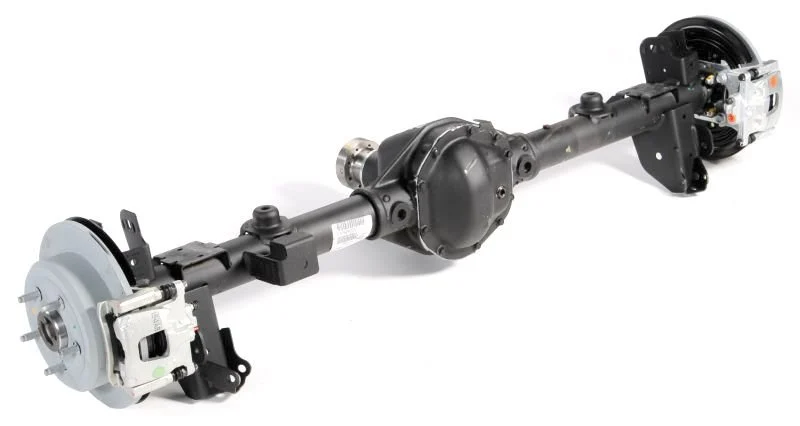What is a Rear Axle Assembly and Why It’s Crucial for Your Vehicle’s Performance?
The rear axle assembly is one of the most important components of your vehicle’s drivetrain, playing a critical role in how your car or truck functions. Whether you’re driving a sedan, truck, SUV, or heavy-duty vehicle, the rear axle assembly is crucial for ensuring smooth operation, safe handling, and overall vehicle performance. But what exactly is the rear axle assembly, and why is it so important? In this article, we will explore the Rear Axle Assembly’s Functions, components, and why it is vital for your vehicle’s performance and safety.
What is a Rear Axle Assembly?
A rear axle assembly is a complex mechanical system that connects the rear wheels of a vehicle to its drivetrain. It is responsible for transferring power from the engine, through the transmission, to the wheels, allowing them to turn and propel the vehicle forward. The rear axle assembly typically consists of several key components, including the axle shafts, differential, housing, bearings, and sometimes, the suspension components.
Components of a Rear Axle Assembly
To understand the role of the rear axle assembly, it’s important to know its main components:
- Axle Shafts: These are the long rods that transmit power from the differential to the wheels, enabling them to rotate.
- Differential: The differential is a set of gears that allow the rear wheels to rotate at different speeds, which is especially important when turning. It splits the power from the engine and sends it to both wheels, but since the wheels on the outside of a turn travel a greater distance, they need to rotate at different speeds.
- Axle Housing: This is the casing that houses the differential, axle shafts, and other components, providing a solid frame for the rear axle assembly.
- Bearings and Seals: Bearings reduce friction and allow for smooth rotation of the axle shafts, while seals help prevent dirt and moisture from entering the axle housing.
- Suspension Components: In some vehicles, the rear axle assembly is integrated with the suspension system, such as leaf springs or coil springs, to support the weight of the vehicle and ensure a smooth ride.
Types of Rear Axle Assemblies
Rear axle assemblies can come in two main types: live axles and dead axles.
- Live Axles: These are more common in rear-wheel-drive vehicles and are responsible for transmitting power to the rear wheels. They include a differential and are usually found in vehicles that require more power to the rear wheels, such as trucks and SUVs.
- Dead Axles: These types of axles are typically used in front-wheel-drive vehicles. While they help support the vehicle’s weight, they don’t transmit power, as the engine power is sent to the front wheels.
Why is the Rear Axle Assembly Crucial for Your Vehicle’s Performance?
The rear axle assembly plays several essential roles in the overall performance and handling of your vehicle. Here’s why it’s so crucial:
1. Power Distribution
The rear axle assembly is responsible for distributing power from the engine to the rear wheels of a vehicle. This power transmission is vital for a vehicle’s movement, especially in rear-wheel-drive and all-wheel-drive vehicles. Without a functional rear axle assembly, the rear wheels would not turn, and the vehicle would be unable to move efficiently.
The differential in the rear axle assembly plays a significant role in distributing power between the two rear wheels, allowing them to rotate at different speeds, particularly when turning. This helps maintain traction and control while driving, preventing the wheels from skidding or dragging during a turn.
2. Handling and Stability
The rear axle assembly plays an integral role in a vehicle’s handling and stability. In many vehicles, especially rear-wheel-drive and all-wheel-drive models, the rear axle assembly helps ensure proper weight distribution. It helps keep the vehicle balanced while accelerating, especially when driving uphill or carrying heavy loads.
The rear axle assembly also works in conjunction with the vehicle’s suspension system, absorbing shocks and bumps from the road. This collaboration results in a smoother ride, better comfort, and more controlled handling, particularly when turning or navigating uneven terrain.
- Rear-wheel-drive vehicles: The rear axle is crucial in transferring power to the rear wheels, improving traction, especially in slippery or off-road conditions.
- All-wheel-drive vehicles: The rear axle ensures that power is evenly distributed between the front and rear wheels, contributing to better traction and stability in adverse driving conditions, such as rain or snow.
3. Towing and Load Handling
For vehicles designed to carry heavy loads or tow trailers, the rear axle assembly becomes even more crucial. The rear axle assembly is designed to handle the increased weight and strain of carrying heavy loads, whether it’s a loaded truck bed or a trailer.
In vehicles like pickup trucks, the rear axle is often reinforced to support the additional stress caused by towing or carrying large items. The differential within the rear axle assembly ensures that both rear wheels rotate at different speeds, improving grip and reducing tire wear when towing.
- Load-Bearing Capacity: The rear axle is built to support more weight in vehicles designed for towing or carrying heavy cargo.
- Enhanced Traction: Proper torque distribution from the rear axle helps maintain traction when towing, especially on uneven or slippery surfaces.
4. Durability and Longevity of the Vehicle
A well-maintained rear axle assembly helps ensure the durability and longevity of your vehicle. If the rear axle assembly becomes damaged, worn, or misaligned, it can lead to poor handling, decreased performance, and even failure of other components.
The axle shafts, differential, and housing must all be in good working order to maintain smooth operation. Regular maintenance, including lubrication of the differential and bearings, can help prevent premature wear and tear. It is also crucial to monitor for any signs of leaks, unusual noises, or vibrations that could indicate a problem with the rear axle assembly.
When neglected, a damaged or malfunctioning rear axle assembly can lead to costly repairs, as it may affect other parts of the drivetrain and suspension system.
5. Enhancing Fuel Efficiency
The rear axle assembly can also have an impact on a vehicle’s fuel efficiency. A well-maintained rear axle helps ensure that power is transmitted efficiently from the engine to the wheels. When the axle and differential are properly aligned and lubricated, there’s less friction, meaning the vehicle doesn’t have to work as hard to move forward. This can contribute to better fuel efficiency and reduce the amount of energy lost during power transmission.
Signs of a Faulty Rear Axle Assembly
While the rear axle assembly is built to be durable, it can wear out over time or become damaged due to external factors like driving over rough terrain. Common signs that your rear axle assembly may be failing include:
- Unusual Noises: Grinding, whining, or clunking noises from the rear of the vehicle could indicate issues with the axle bearings or the differential.
- Vibrations: If you experience vibrations or a shaking sensation while driving, it could be a sign of an issue with the axle shafts or alignment.
- Fluid Leaks: Leaking fluid around the rear axle housing can indicate a seal or gasket failure, which may lead to axle damage if left unaddressed.
- Poor Handling: Difficulty steering, pulling to one side, or loss of control, especially when turning, could be a sign of a problem with the axle or suspension components.
If you notice any of these signs, it’s important to have your vehicle inspected by a professional mechanic to avoid further damage.
Conclusion
The rear axle assembly is an essential component in ensuring that your vehicle runs smoothly, handles well, and remains stable under various driving conditions. From power distribution and handling to towing capacity and fuel efficiency, the rear axle assembly plays a key role in your vehicle’s overall performance. Regular maintenance and prompt attention to any issues can extend the lifespan of the rear axle assembly and prevent costly repairs in the future. By understanding the importance of this critical component, you can better appreciate how it contributes to a safer, more efficient driving experience. You can visit Trendinghub24 to get more information.




